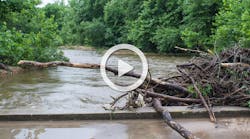About the author: Jeff Porter is project manager for Sanco Design. Porter can be reached at [email protected] or 972.424.7377.
Inlet protection is a very broad topic. There are many different types of inlets and just as many types of inlet protection devices. Finding a protection device that is suitable and that will work effectively for any given type of inlet is a top priority on a project.
Most problems occur when inlet protections are not installed or maintained properly. This can be a major issue when it comes to enforcement. Street inlets are there for a reason. The design of the inlet protection is meant to allow water to pond or pool, letting sediment settle prior to the water flowing over the device and into the storm drain.
Ensuring that the inlet protection is implemented appropriately and working correctly is part of an inspector’s responsibilities, as is communicating this information to the owner/operator or the party that receives the inspection reports.
Installation Pointers
The first case to highlight involves a subdivision in which several homebuilders used a z-dyke. The first discovery during the inspection was that the inlet protection was not installed correctly due to a measurement miscalculation.
In this case, the inlet protection stopped a few inches short of the edge of the inlet. This is cause for a notice of violation from the municipal separate storm sewer system or other regulatory inspectors. It is important that the inlet protection is at least 4 to 6 in. longer at each end of the inlet. For instance, if the inlet is 10 ft wide, then the site needs an 11-ft inlet protection.
A gap existed between the curb and the back of the inlet protection as well. The installer did not make sure that the inlet protection conformed to the curb and gutter. Sometimes it is difficult to make the products conform due to the gauge of the wire used in manufacturing. Rock bags or sand bags can be used to make up the space between the curb and gutter, giving sediment a place to settle.
Furthermore, the front edge is not flat and conforming to the gutter. This is the case in most z-dyke applications and can be remediated with the installation of rock bags or sand bags.
Experts often receive inquiries regarding straw bales for inlet protection. While bales are potentially effective, their longevity is short-lived and they do not provide the desired results when installed improperly.
As the subdivision develops and the sediment lessens, there are other technologies that can catch the sediment, create less mess and keep the site more compliant.
Additional Considerations
When performing an inspection, one has to consider safety as well. Mud and sediment in the street can cause traffic issues. Daily street sweeping is recommended to prevent this from happening. Even in the drought-stricken Southwest, a thunderstorm can pop up and make a huge mess of a site.
On commercial sites, one usually will not find typical street inlet protection until later in the project. Existing inlets in the streets leading to the project site or nearby, however, also must have protection.
Many things can change in just one week between inspections; this is where communication with the general contractor becomes key. It is important to ensure adequate protection for each new inlet, then note and update the best management practices maps. A good inspector uses these maps in his or her daily activities.
As a project progresses, inspectors find the storm drains are being installed. Storm drain pipe that is halfway installed needs to have some type of protection at the end of each working day. Then, as the last stages of concrete are ready to be poured, inspectors must make certain that all inlets are protected.
The inlet has a woven fabric installed to collect sediment. The only issue to contend with here is that the soil around the inlet needs to be about 4 to 6 in. below the top of the inlet.
After paving has been completed, the project team can use other applications (e.g., log rolls and mats). During construction, workers need to keep ponding at a minimum. The location and extent of ponding—and the extent of diversion—usually can be controlled through appropriate placement of the inlet protection device. In some cases, moving the inlet protection device a short distance upstream of the actual inlet can provide more efficient sediment control, limit ponding to desired areas, and prevent or control diversions.
Inlets are the starting points that feed the creeks and streams that fill lakes and waterways. Good communication is the key to helping contractors, developers and homebuilders achieve their goals.

